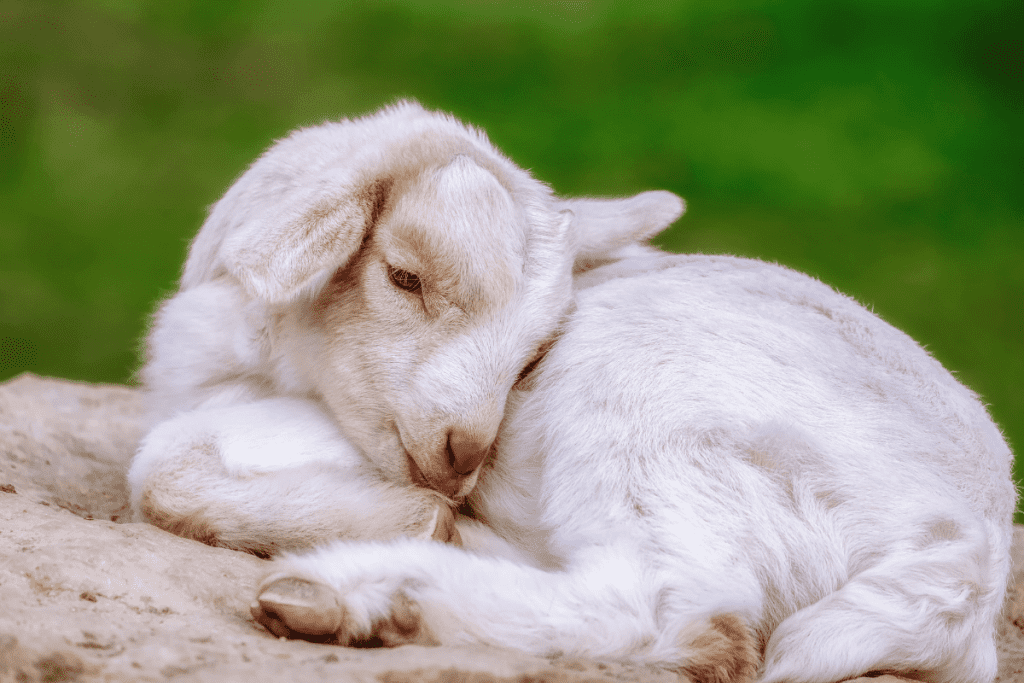If you are new to being around goats, you probably worry a lot about their health and well-being.
When the goats my wife and I adopted gave birth and saw the kids with the stumps of their umbilical cords sticking out, we worried something was wrong.
The umbilical cord will typically fall off in a little over a week. However, it can take longer, up to 6 weeks in some instances, so do not be overly concerned if it stays awhile. What you’ll notice over time is the cord shriveling as it dries, indicating the cord stump is nearly ready to detach itself from the goat.
Our first experience with baby goats was fraught with worry:
How was the mother doing?
Will the birthing be problematic?
Ultimately nature took care of itself and what we did next ensured our new kids would be happy and healthy.

Table of Contents
ToggleCaring For And Nurturing Your Baby Goat
The umbilical cord will naturally break from the mother; if you notice it is still connected, don’t force it.
It will detach.
If the navel cord is exceptionally long, say over 6-7″ inches, it’s okay to trim it, but leave a length around 4″ inches.
Examine the condition of the umbilical cord stump and apply an iodine solution.
Iodine will help ensure the umbilical area does not get infected.
Betadine Solution 5% Povidone-iodine Antiseptic Microbicide is highly recommended for this process.
A solution of up to 7% may be used but do not go above this number.
It is important to continue cleaning the cord area with Iodine over the next couple of days.
Two to three times per day is sufficient, or whenever the goat has been handled.
Other Potential Goat Umbilical Cord Issues
A newborn’s umbilical cord provides a prime avenue for bacteria to cause infection.
The most common affliction is “Navel Ill” or the more descriptive “Joint Ill.”
While the cord is not the only vector for this sickness, it is common.
Joint Ill causes joints in the leg to become inflamed, thus possibly affecting mobility.
This condition is easily treated with antibiotics, however.
The medicine augments their immune systems and helps fight off infection.
Another common issue that might arise is an umbilical hernia.
This is a serious condition requiring immediate surgery.
And occasionally, the cord will develop reddish scar tissue and look like it is not healing.
This condition is called Granuloma and is relatively benign; allow about a week for it to go away.
Just keep your baby goat happy and clean, and it usually resolves.
If it persists, call your animal’s health provider.
If you do notice signs of infection around the umbilical area, such as redness, swelling, or pus discharge, it is best to contact your vet for a consultation.
An infection in a newborn is very serious, although it is quite rare.
Again, proper cleaning of the area will effectively eliminate an infection.
Suckling Issues In Goats
Overall, goats are healthy, robust animals, but sometimes problems do occur.
Umbilical cord separation at birth eliminates the baby goat’s primary food source from the mother, and so they must begin suckling right away.
One of our goats gave birth to three kids.
Two of them began suckling immediately while the third goat, a runt, had a difficult time, even though the mother tried to help.
At this point, we took the little guy indoors and fed him ourselves.
He was so small his suckling reflex was very weak, so we started him off with a 200 ML syringe and baby goat formula or milk replacer.
The formula we used was Manna Pro Colostrum, but a wide selection of others is available.
After a short period, we switched to our concoction of one-gallon whole milk, one cup of buttermilk, and one can of evaporated milk.
It took several weeks before he started to gain weight noticeably.
Keep Goat Pens Sheltered Clean and Dry
Healthy living space and basic goat care cannot be overstated.
As goats generally relieve themselves whenever and wherever they feel, you will need to maintain good housekeeping, especially in the rearing area.
Remove the old straw and replenish with fresh straw as needed, at least every fourth day for the first month.
While we prefer using straw in our goats’ pen, other preferences abound.
Ultimately a clean, dry environment drastically reduces the chances of goats getting an infection or other problems like worms.
Elements Of Goat Care And Cleanliness
Remember, the key consideration for your goats’ health, especially the babies, is attention to their living area.
Ensuring they have adequate ventilation, freshwater, and clean bedding is essential.
Just remember these points:
Ventilation: Fresh air is important to everyone but especially for the young.
An adequate supply of fresh air prevents respiratory issues and helps prevent sickness from spreading in the pen.
Water: Just like fresh air, freshwater is a daily necessity.
Changing the water often reduces the risk of disease transmission and reduces parasite transmission.
Check out these other ways to give goats more water.
Clean Bedding: Stay on top of the bedding situation.
Dirty living space will encourage the spread of germs, infections, and parasites.
Think of this as a religious obligation.
We have stated how goats are robust animals, and they most certainly are.
With proper care and attention, your little guys will get through their first few weeks of life simply fine; and before too long, you’ll enjoy the antics of these curious little scamps.
How useful was this post?
Click on a star to rate it!
We are sorry that this post was not useful for you!
Let us improve this post!
Tell us how we can improve this post?
